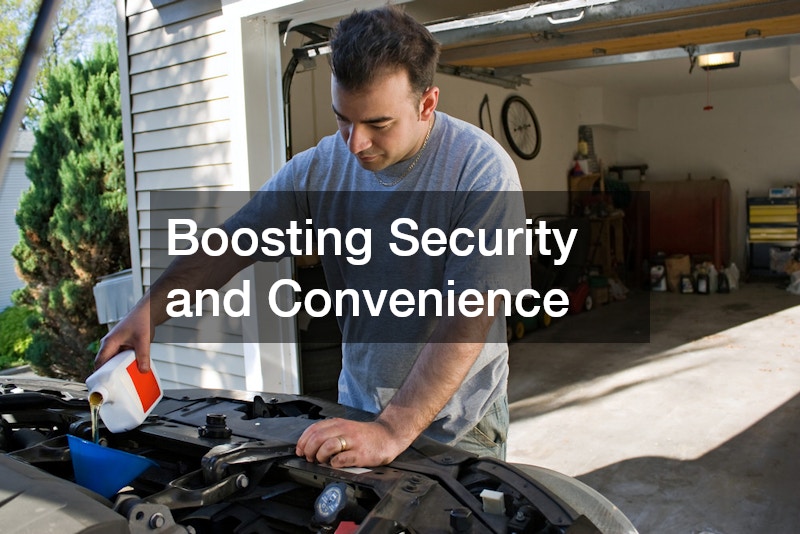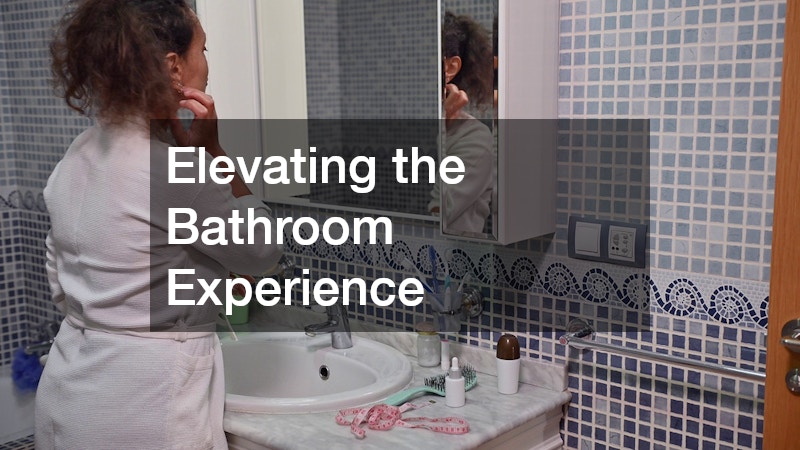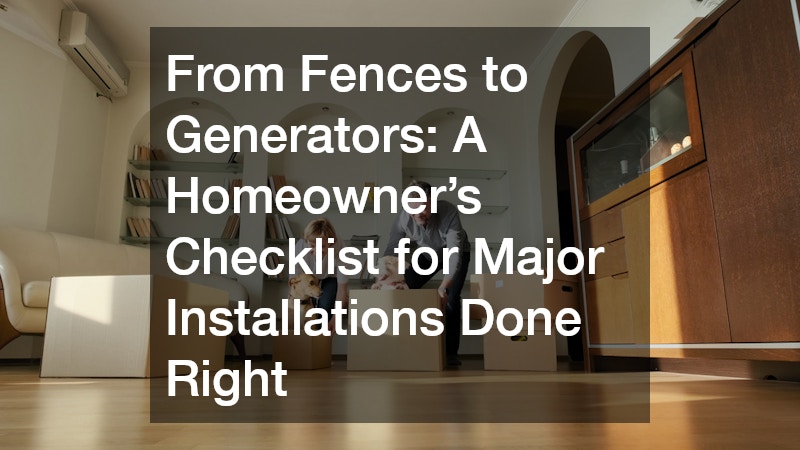Upgrading your home with major improvements can be exciting, but it’s also a project that requires careful planning. Whether you’re looking to improve curb appeal, boost energy efficiency, or simply make your living space more comfortable, the right approach to installations can make all the difference. Many homeowners get caught up in the thrill of a new feature without considering the full scope of what’s involved—budgeting, scheduling, material selection, and choosing reputable contractors. That’s why having a checklist is more than just helpful; it’s essential.
This guide breaks down ten major home upgrades you might be considering, from fencing and shading solutions to plumbing, HVAC, and outdoor landscaping. Each section will walk you through what to expect, how to prepare, and what questions to ask before work begins. By thinking through the process ahead of time, you can avoid costly mistakes, prevent scheduling conflicts, and ensure every new feature is installed to last. A well-organized homeowner doesn’t just save money—they also gain peace of mind knowing the job is done right the first time. Let’s walk through each upgrade so you can make informed, confident decisions for your property.
Defining Property Boundaries With Style
If you’re looking for a durable and low-maintenance way to enhance your home’s exterior, installing an aluminum fence is a strong option. Unlike wood, which requires frequent painting or staining, aluminum offers long-term weather resistance and a sleek, modern look. Before starting, determine the exact boundaries of your property and check with local authorities for any permitting requirements. This prevents legal disputes with neighbors and ensures compliance with zoning laws.
Another key consideration is choosing the right style and height for your fence. Some designs prioritize privacy, while others focus on open views and decorative appeal. Your contractor should discuss various panel options, post styles, and finishing techniques. Proper preparation of the ground before installation will improve stability and longevity. Also, think about whether the fence will need gates for vehicle or pedestrian access, as these add both function and cost. By carefully mapping out the project and partnering with a reliable contractor, you can get a fence that not only looks good but also stands the test of time, becoming a long-term investment in your home’s value and security.
Adding Shade and Comfort to Outdoor Spaces

Creating a comfortable outdoor living area often starts with shade solutions, and a retractable awning install can transform how you use your patio, deck, or backyard. The ability to extend or retract the awning depending on weather conditions provides flexibility for both sunny days and unexpected rain. Before choosing a model, consider your home’s architectural style, the awning’s fabric durability, and whether manual or motorized operation is best for your lifestyle.
Proper installation begins with selecting the right mounting location to ensure structural stability. Your installer should secure the awning to a load-bearing surface, such as wall studs or reinforced beams, to prevent sagging or damage in high winds. It’s also worth asking about UV protection ratings, as quality materials will shield both people and outdoor furniture from sun damage. Homeowners often pair awnings with outdoor lighting or heating features to extend usability into evenings and cooler seasons. With thoughtful planning, a retractable awning can do more than provide shade—it can enhance comfort, encourage outdoor dining, and boost your property’s appeal. And when installed correctly, it’s a low-maintenance addition that will serve your family for years to come.
Staying Cool and Efficient Indoors
When temperatures climb, a reliable cooling system becomes essential, and professionally handled air conditioning installations can ensure comfort while reducing energy waste. Before committing to a unit, evaluate the size of your home, insulation quality, and climate conditions. An undersized unit will run constantly, struggling to maintain temperature, while an oversized system can cause humidity problems and uneven cooling.
Modern AC units often come with advanced features like programmable thermostats, variable-speed fans, and energy-saving modes. A qualified technician should perform a load calculation to determine the proper system capacity for your space. Placement of the outdoor condenser unit also matters—keeping it shaded can improve efficiency, but it must have adequate airflow. Inside, ductwork should be inspected and sealed to prevent air leaks, which can significantly impact performance. Once installed, scheduling annual maintenance helps keep the system running smoothly and extends its lifespan. Choosing a trusted HVAC contractor means you’ll not only enjoy a cooler home but also lower utility bills and fewer repair headaches over the years.
Boosting Security and Convenience

A well-chosen and properly executed garage door installation can dramatically improve your home’s security and curb appeal. Modern garage doors come in a variety of materials, including steel, wood, aluminum, and composite, each offering different benefits in durability and insulation. Homeowners should consider the style of the home, the climate, and maintenance requirements before deciding on a material.
In addition to aesthetics, security features play a vital role. Many doors now include reinforced panels, advanced locking systems, and smart openers that allow remote operation from a phone app. Proper alignment and balance of the door during installations are crucial for smooth operation and to prevent strain on the opener. Safety sensors should be tested to ensure they function correctly, protecting people and pets from accidents. Adding insulation to the door can also improve your home’s overall energy efficiency, especially if the garage is attached. A professional installer will ensure that all components work together seamlessly, providing long-term reliability and ease of use.
Reliable Hot Water When You Need It
Few home upgrades have as immediate an impact on daily comfort as a water heater installation. Whether you opt for a traditional tank model or a tankless system, the process starts with assessing your household’s hot water usage. Tank systems are generally less expensive upfront, while tankless units offer on-demand hot water and can save space.
Proper sizing is key—too small, and you’ll run out of hot water during peak use; too large, and you’ll waste energy heating water you don’t need. Venting requirements, electrical capacity, or gas line sizing must also be verified before installation begins. Choosing a unit with a high energy efficiency rating can reduce monthly utility bills, and some models may qualify for rebates. Once installed, routine maintenance such as flushing the tank or descaling the heating elements will extend its lifespan. A skilled installer will ensure the system is safely connected, properly vented, and meets all local building codes. With the right setup, you’ll enjoy consistent, efficient hot water for many years.
Elevating the Bathroom Experience

Transforming a bathroom often involves upgrading its fixtures, and a glass shower enclosure install can give the space a modern, open feel. Unlike shower curtains or framed doors, frameless glass enclosures create a sleek, seamless appearance that makes the bathroom feel larger. Before installation, measurements must be precise—glass panels are custom-cut and tempered for safety, so any sizing errors can cause delays and added costs.
The type of glass and hardware you choose will influence both aesthetics and maintenance. Clear glass offers an open, airy look, while frosted or textured glass provides more privacy. Hardware finishes should coordinate with existing fixtures for a cohesive design. Water-proofing and proper sealing are critical to prevent leaks and mold growth. Experienced installers will ensure the panels are securely anchored to the walls and floor, maintaining alignment over time. With the right care, a glass shower enclosure can last for decades while adding value and sophistication to your home. This is one bathroom upgrade that delivers both beauty and practicality in equal measure.
Enhancing Outdoor Living Areas
Creating a functional and visually appealing yard often starts with a well-planned hardscape installation. Hardscaping refers to the non-plant elements of landscaping, such as patios, walkways, retaining walls, and decorative stone features. These structures provide definition, improve drainage, and make outdoor spaces more usable.
Before work begins, evaluate how the area will be used—do you want a space for dining, lounging, or entertaining? The choice of materials, whether pavers, flagstone, or concrete, will influence the look and durability of the project. Proper site preparation, including grading and base compaction, ensures that surfaces remain level and resistant to shifting. Drainage solutions must be incorporated to prevent water pooling or erosion. Hardscape elements can also be paired with lighting for safety and ambience, making them functional day and night. Skilled contractors will not only bring design expertise but also ensure compliance with local codes and long-lasting results. By combining aesthetics with practicality, a well-executed hardscape can transform your outdoor space into a true extension of your home.
Creating Safe Play Areas for Kids

Families with young children often look for ways to make their yards more engaging, and hiring professional playground installers ensures both safety and quality. While DIY options may seem tempting, playground equipment must meet strict safety standards regarding height, spacing, and surface materials. An experienced team can help you select equipment suited to your children’s ages and abilities, from swings and slides to climbing structures.
Installations begin with choosing a level location and preparing a soft landing surface, such as rubber mulch or engineered wood fiber, to reduce injury risks. Anchoring equipment securely into the ground is essential for stability. Professionals also verify that there is adequate clearance around swings and slides to prevent accidents. In addition to safety, aesthetics matter—color schemes, layouts, and additional features like shade structures can make the space more inviting. With proper planning and installations, a backyard playground can provide years of enjoyment while giving parents peace of mind that the equipment is safe and durable.
Protecting Your Gutters and Home Exterior
Keeping your gutters free of debris is essential for preventing water damage, and professional gutter guard installations can greatly reduce maintenance needs. These protective covers prevent leaves, twigs, and other debris from clogging gutters, allowing water to flow freely away from your home’s foundation. Choosing the right type of guard—mesh, screen, or reverse-curve—depends on your local climate and the types of trees near your property.
Thorough installations involve cleaning and inspecting the existing gutters to ensure they are in good condition before adding guards. Proper attachment methods will prevent the guards from shifting during storms or under heavy leaf loads. In addition to reducing the need for ladder cleaning, gutter guards can also help prevent ice dams in colder climates by keeping water moving. Homeowners who invest in this upgrade often find that their gutters last longer and require less frequent repairs. By working with experienced installers, you can ensure that the guards perform effectively for many years.
Ensuring Power During Outages
For homeowners in areas prone to severe weather or unreliable utility service, a standby generator installation offers peace of mind. These systems automatically activate during a power outage, keeping essential appliances and systems running until electricity is restored. Before installations, determine your power needs—will you run only critical systems like heating, refrigeration, and lighting, or do you want whole-house coverage?
Generator size and fuel source, such as natural gas or propane, must be matched to your requirements. The location of the unit should be chosen to meet safety codes, avoid noise disruption, and allow for proper ventilation. Professional installation includes connecting the generator to your home’s electrical panel through a transfer switch, which prevents dangerous backfeeding into the utility grid. Regular maintenance, including oil changes and system testing, ensures reliability when you need it most. For many homeowners, this upgrade is not just about convenience—it’s about security, safety, and protecting investments during emergencies.
Major home upgrades can significantly improve comfort, safety, and property value, but success depends on planning ahead. Understanding the scope of each project, from fencing to emergency power, allows you to set realistic budgets and timelines. By working with qualified contractors, securing necessary permits, and selecting durable materials, you can ensure each project is completed to a high standard.
This checklist serves as a starting point, helping you approach installations with confidence. Whether it’s a decorative fence, an efficient water heater, or a generator to weather the next storm, each improvement adds to the overall functionality and appeal of your home. Prioritizing safety, quality, and professional expertise ensures that these investments will provide benefits for years to come. With careful coordination, you can enjoy the excitement of upgrading your home without the stress of unexpected setbacks.



